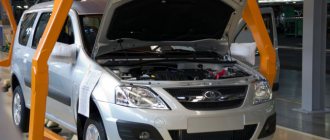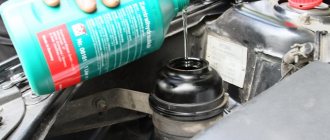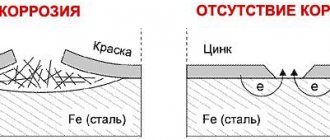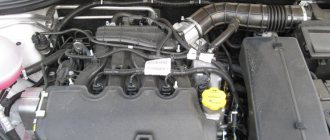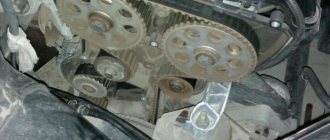| Home News About the company Capacity charts Reviews Videos Prices Shop Contacts |
Chip tuning Lada Largus (Lada Largus) is a change in software (chip, firmware) of an electronic engine control unit or robotic transmission to increase power, reduce fuel consumption, eliminate failures, and ensure stable operation of the engine control system.
Largus station wagon, Cross, CNG cars with VAZ and Renault engines with M86 control units (Itelma, Avtel) and Siemens Continental EMS are available for tuning. We use software from leading Russian developers: Paulus chip, ADACT, Ledokol.
The proposed chip tuning software is intended for use on ordinary (non-sports) cars without the goal of obtaining maximum power and torque, without reducing the service life of the units.
You'll get a well-balanced increase in power and torque not only at high rpm under full load, but also in the low and mid-range, without increasing emissions.
After installing the modified software, improved driving characteristics can satisfy even the most demanding car owners.
The firmware is focused on comfort in driving a car: elimination of factory software errors, elasticity, confident starting at any temperature, no dips and twitching, freezing of speed, elimination of sluggish acceleration dynamics, hesitation and jerking of manual transmission, excessive fuel consumption. When the air conditioner is turned on, the loss of engine power is significantly reduced. In addition, it is possible to eliminate errors due to non-functioning oxygen sensors (lambda probe), remove the software catalytic converter (catalyst), and also transfer the car to Euro 2 econorms.
The appearance of error codes P0130, P0131, P0132, P0133, P0134 and other errors associated with a faulty lambda probe, catalyst errors P0420, P0421, 0422, P0423, P0124, P0430 can be eliminated forever with the help of reprogramming and without compromising the driving characteristics of components and units.
The warranty for the operation of the modified software extends to the entire service life of the vehicle, that is, indefinitely. Working time 1 hour. For each car, a certificate is issued with a unique authentication code, which can be verified on the software developer’s website.
How to increase the power of an internal combustion engine
In general, the power of the power unit can be increased by:
However, currently there is so-called chip-tuning (chip-tunning, from English microcircuit tuning) - a technique for increasing power that does not require changes to the design of car engines. The use of chip tuning makes it possible to optimize or improve the performance characteristics of any car, including the LADA Largus family station wagon, which has been produced by AvtoVAZ OJSC since 2012, without resorting to changing the engine design.
Power units of the LADA Largus car
The LADA Largus and LADA Largus Cross cars are developed on the basis of the popular Renault (Dacia) Logan MCV station wagon and differ from the prototype in the suspension adapted for domestic roads. They are equipped with gasoline 4-cylinder French power units with a cylinder capacity of 1.6 liters:
In addition, the LADA Largus is equipped with a 1.6-liter VAZ-11189 engine with a power of 87 hp. pp., which is a VAZ-11186 engine adapted to EURO-5 requirements.
Long-term operation of the LADA Largus and LADA Kross station wagons has shown that all the engines they are equipped with are somewhat weak. At the same time, the use of traditional methods of functional (mechanical) tuning, which boil down to making changes to the design of power units, does not produce significant results. The easiest way to eliminate this drawback without changing their design is to use modern chip tuning technologies.
Lyrical digression
So you decided to do Chip tuning, you come to the service center and declare your desire... The master comes out, inserts the laptop plug into the connector, presses the buttons and after a few minutes announces - “... The car is ready, from you N-000 rubles, I’ve done everything... " Or another option - several owners of the same brand gather at the same time (to make it cheaper), call the specialist, he arrives at a certain meeting place with a laptop, 20 minutes in advance. “changes” 4-5 cars and, satisfied, how could it be otherwise, having received the money, he leaves. Now the question is - what will be fair to you, as the owner who spent the money? An example from life - a young man comes to 2115 with a desire to do Chip tuning, I outline the methodology, he says - “... I only need a Chip, I already did the diagnostics there yesterday, everything is fine with me...”. I answer, “... I must be sure that the car is in good condition, since I give a guarantee for my work...”, I check - I find a faulty air flow meter, spark plugs - I say that I need to go to the store, buy it and replace it, I won’t flash it without replacing it. His friends declare: “... You’re making money here, we’ll go somewhere, there’s a Master there, he’ll do everything cheaper and won’t change anything.” Agree that the actions of the guys are devoid of elementary logic, then what is the difference between the owners who gathered in a group and did Chip tuning in 5 minutes for touring artists from St. Petersburg, Moscow, etc.? Do they feel deceived?
CHIP tuning of LADA-Largus engines
Improving the dynamic characteristics of LADA Largus power units using chip tuning is ensured by modifying and correcting factory settings in the program that directly controls the operation of the engine. Factory firmware is averagely balanced between such operational characteristics of a particular power unit as power, reliability and environmental friendliness. Unfortunately, they do not always provide optimal engine operating conditions under various operating conditions of the vehicle. You can change the factory settings of the engine electronic control unit (ECU) using special equipment and professional software (chip tuning).
Today, chip tuning of LADA Largus car engines can be carried out in two ways (the type of engine does not matter significantly):
Flashing the ECU
The factory firmware of the ECU is a set of two or three-dimensional tables (maps), which are connected by a certain sequence and stored in a chip (integrated circuit). The number of these cards and the data contained in them depend on the specific engine type. Access to them is possible only with the help of a special programmer and professional software. To connect the equipment, a special OBD diagnostic connector (port) is used, which is located in the vehicle interior. There is no need to dismantle the ECU.
High-quality chip tuning on the LADA Largus can only be done on a working engine. Diagnosis of the latter's ECU is carried out before specialists begin work. Their comments must be eliminated, otherwise the entire chipping procedure will not make sense.
Reflashing the factory settings of the ECU is carried out step by step in a certain order:
This completes the flashing process. During the chipping process, new firmware is introduced into the ECU, which changes the modes:
Chip tuning of the factory ECU settings increases engine power and torque by approximately 10%.
Installation of chip tuning boxes
Currently, this type of chip tuning is in great demand, such as installing an original power module (chip tuning box). Installation and proper configuration allows you to increase both the torque and power parameters of the motors. In addition, the stability of the power unit increases:
The chip tuning box is installed under the hood of the car and is connected to the engine through the sensors and connectors available on it. For this purpose, a multi-channel cable is included in the package.
Structurally, the chip tuning box is a body made of impact-resistant fiberglass reinforced with a metal lid.
The operating principle of the chip tuning box is to adjust control signals outside the ECU. The most important element of the device is a printed circuit board with electronic components installed on it. Its operation is controlled by a microprocessor, which does the main work of improving the dynamic characteristics of the engine. The main advantage of the chip tuning box when installing it on LADA Largus is the adjustment of control cards without changing the standard ECU software. In this case, no changes are made to the design of the power unit or ECU. At the same time, the car owner is given the opportunity to independently adjust the output power parameters, which are displayed on the LED panel of the unit.
The chip tuning box is as easy to dismantle as it is to install. In this case, all factory settings are restored independently.
Installing a chip tuning box on LADA Largus allows you to:
Source
Firmware for audio device on Lada Largus
The standard head unit on cars of this model does not look very presentable, but at the same time the functionality is complemented by a large number of possibilities. Unfortunately, despite the decent quality of the technical part, the manufacturers did not pay enough attention to the software. It's no secret that modern audio systems have a full-fledged electronic control unit, which is a kind of computer. There is a processor, devices for reading removable media, various connectors and other functionality. In addition, the standard radio is combined with the on-board computer.
On the other hand, the more complex the audio system, the greater the likelihood of failures and malfunctions. The radio installed on the Lada Largus is no exception to the rule. The software has not been properly tested, so malfunctions are not uncommon. The most common problems are the inability to recognize the file format, reproduce high-quality sound, or identify the removable storage device. Also on Largus, incorrect display of Russian fonts on the display is often encountered. As a result, instead of the usual Cyrillic alphabet, the driver sees incomprehensible symbols. It is in these cases that updating the device firmware will help solve the problem.
Does Lada Largus need additional anti-corrosion treatment?
The first of the two engines is equipped with 16 valves, and it became the basis for all trim levels of the crossover station wagon. It is this, and not the 8-valve K7M, although 8-valve internal combustion engines are more suitable for the SUV segment. In fact, the K7M engine is inferior to its 16-valve brother in both power and traction characteristics. And if the Lada Largus Cross engine had been 8-valve, neither the factory nor the buyer would have benefited from this. Let's look at the details.
The following video lists tips that are relevant for every owner of a Largus crossover.
How much will be added?
By the way, what moves the car forward is not power, but TORQUE - the product of force and the arm of the lever to which it is applied. To be brief, it is the amount of torque that is important for accelerating a car, and the better it will accelerate, the greater the torque for the required engine speed. Power is a derivative of torque, and the higher it is in the end, the faster the car will be. In other words, for a car to accelerate quickly and be flexible, torque is needed, and for it to drive quickly, power is needed. So, I repeat, after programming, the torque increases and shifts to the region of lower speeds and at the same time, as a derivative of the torque, the power increases accordingly. In the end - in good working order! The car will have lower fuel consumption with increased torque and power. It will be more pleasant to operate the car, at lower costs. I think everyone strives for this.
And so, after pre-programming we get:
- on naturally aspirated engines, torque and power increase by 8-10%.
- on turbocharged engines, the increase in torque can reach 40% and power by 35%.
If your car with a naturally aspirated engine has a passport rating of 100 hp. and 140 Nm of torque, then after programming the car will have 110 hp. and 154Nm respectively. If the engine is turbocharged and has the same 150 hp. and 210 Nm, after reprogramming it will be about 190 hp. and 270 Nm.
What is the difference between the 1.6 16 valve engine Lada Largus 21129 and 21127?
Firstly, the 21129 engine is a modified version of the 21127, which differs primarily in toxicity standards. 21129 is adjusted to EURO-5 toxicity standards in order to obtain approval under current legislation.
Secondly, the compression ratio has been changed. 21129 the engine was literally “unclamped” to make it possible to use AI-92 class fuel. The 127 engine did not have this option.
Thirdly, the 129 1.6 Lada Largus engine with 16 valves has a modified intake and exhaust, which has a positive effect on the dynamics of the car.
Fourthly, the 129 motor runs under a new engine control unit with a modified program.
Fifth, the engine mounts have been modified to reduce vibration from the powertrain.
And this is just a small part of the changes that affected engine 21129. In fact, there were much more, but alas, many, seeing that the engine is similar in appearance, think that no changes were made. If we dig deeper, we will see that the piston rings have become thinner and the piston has become lighter. This was done to reduce friction and increase engine life, as well as improve the overall performance of the engine.
What is chip tuning
The phrase “chip tuning” is formed from two words: “chip” - microcircuit, and “tuning” - improvement. The essence of the process is to change the engine control algorithms of the electronic unit to achieve better results - finalizing the factory characteristics. The ECU operates according to a specific program, which is stored in a ROM type memory (read-only memory), in accordance with various calibration tables (two- or three-dimensional). There are calibrations for different engine operating modes - starting, idling, power - and are used depending on how exactly the engine operates at a particular moment. Sensors transmit data to the controller, and it issues commands to the executive units, ensuring and maintaining stable engine operation. When adjustments are made to the calibration tables, the operating algorithm of any unit controlled by the ECU changes.
To increase power, you can change the ignition timing, fuel injection time, and the operating mode of the catalyst responsible for the toxicity of exhaust gases. You can also increase the maximum speed and many other parameters.
Chip tuning is firmware that improves the functionality of a car. It allows you to install additional electronic modules, including replacing the standard ECU with a modernized one, followed by adjusting the operating parameters of the power plant. In most cases, chip tuning involves manipulation of the factory controller.
Advantages
The Largus engine has a reserve of power and does not work at full capacity. Controller firmware will help:
Such tuning is simpler than a deep modernization of the engine - installing a turbine or boosting it. Installing the firmware takes no more than an hour, while the work listed above can take a week or more. Among the advantages of such modernization:
The settings are selected according to your driving style - from economical to aggressive. Combined software has become in demand, with the help of which maximum results can be achieved from the engine.
After the firmware, there is a general improvement in performance and an increase in performance relative to the standard version by about 20%.
Flaws
Chip tuning has fewer disadvantages than advantages, but each of them can “discourage” the desire of car enthusiasts to flash the ECU. Negative aspects of the procedure:
These shortcomings may discourage those wishing to improve the parameters of the Lada Largus engine. If you approach the matter competently and find good specialists, then the risk of “killing” the motor is minimal.
Engine Lada Largus 1.6 16 valves - technical characteristics
| Manufacturer | AvtoVAZ |
| ICE index | 21129 |
| Years of manufacture | 2015–present |
| Volume, cm3 (l) | 1597 cm3 (1.6 l) |
| Power (hp) | 78 kW (106 hp) |
| Torque Nm (rpm) | 148 Nm (at 5800 rpm) |
| Weight, kg | 110 kg |
| Compression ratio | 10,5 |
| Nutrition | injector |
| Motor type | in-line |
| Injection | distributed electronically controlled |
| Ignition | coil for each spark plug |
| Number of cylinders | 4 |
| Number of valves | 16 |
| Cylinder head material | aluminum alloy |
| Cylinder block material | cast iron |
| Cylinder diameter | 82 mm |
| Piston stroke | 75.6 mm |
| Fuel | AI-92/AI-95 |
| Environmental standards | EURO-5 |
| Fuel consumption | highway – 5.3 l per 100 km |
| combined cycle 6.6 l per 100 km | |
| city – 9 l per 100 km | |
| Oil consumption | maximum 0.1 l/1000 km |
| Motor life | stated 200,000 km |
| real 300000 km | |
| Adjustment of valves | hydraulic compensators |
About the domestic VAZ 11189 engine
In April 2022, AvtoVAZ began installing domestic VAZ 11189 engines on Largus. The advantages of this engine are described in one of the issues of “Okay Mechanics”.
| Some measurement results Autoreview | |||
| Options | Cars | ||
| Lada Largus (VAZ engine) | Lada Largus (Renault engine) | ||
| Maximum speed, km/h | 157,1/156,7* | 168,0/167,6 | |
| Acceleration time, s | 0—50 km/h | 4,3/4,8 | 3,9/4,4 |
| 0—100 km/h | 13,9/16,8 | 12,5/14,5 | |
| 0—150 km/h | 61,1/71,6 | 38,9/43,7 | |
| on the way 400 m | 19,3/20,2 | 18,4/19,4 | |
| on the way 1000 m | 36,1/37,8 | 34,1/36,0 | |
| 60-100 km/h (III) | 8,7/10,6 | 9,3/10,6 | |
| 60-100 km/h (IV) | 12,1/15,1 | 12,8/14,1 | |
| 80-120 km/h (V) | 19,3/24,0 | 22,1/23,4 | |
| * Partial load/full load | |||
| Engine characteristics | ||
| Options | VAZ-11189 | Renault K4M |
| Volume, cm 3 | 1596 | 1598 |
| Number of valves | 8 | 16 |
| Maximum power, hp/kW/rpm | 87/64/5100 | 102/75/5750 |
| Maximum torque, Nm/rpm | 140/3800 | 145/3750 |
| Cylinder diameter/piston stroke, mm | 82,0/ 75,6 | 79,5/80,5 |
| Compression ratio | 10,3:1 | 9,8:1 |
| Injection type | distributed, electronically controlled | |
| Octane number of gasoline | at least 92 | not less than 95 |
Let us remind you that you can read about the VAZ 21129 engine here.
Key words: Lada Largus engine
Dimensions
Chassis
Fuel
Foreign analogue
The original model of this car is the French development of Dacia Logan MCP. It is produced at factories in Romania. This is a station wagon car and belongs to the “B” class of cars. Now it is one of the most popular family cars in Western Europe. The appearance and technical characteristics of the Lada Largus are very similar, but there are also significant differences. First of all, this is the radiator grille, which makes the design of the Russian vehicle more stylish and fashionable.
Dacia Logan MCV - one might say, this is the father of our Lada Largus
Disadvantages of the Lada Largus 1.6 16 valve engine
1. The first and most unpleasant drawback that the 1.6 engine from Lada Largus has is increased oil consumption. Although, according to the manufacturer’s stated data, the maximum oil consumption should not exceed 100 ml per 1000 km, in fact this figure can be 2.5 times higher. Of course, this problem will not affect many at all, but for many it will be an unpleasant surprise. However, you should not immediately run to a car service center and ask to have the engine rebuilt due to increased consumption. You may simply have chosen the wrong engine oil.
2. The second significant drawback is the bending of the valves when the timing belt breaks . Yes, engine 21129 bends the valve when the timing belt breaks. Unfortunately, nothing can be done about this problem. There is only one way out - timely change the timing belt and rollers and monitor their condition.
3. The third drawback is the knocking of the hydraulic compensators. Since valve clearance is regulated by hydraulic compensators, they tend to knock. This can occur both on a cold engine and on a hot one. Most often, this problem is caused by low-quality engine oil or its untimely replacement. But this drawback exists and does exist.
Chip tuning in a car service
The chip tuning process in specialized organizations looks approximately the same. The car owner comes to the service center, where, using special equipment, the factory firmware is read from the control unit. It is then modified depending on the client’s wishes - to reduce fuel consumption, increase power, remove the speed limit. After this, the ECU is flashed with a modified program.
Often, such services already have a set of programs for different cars - in this case, the duration of the procedure is reduced. After installing the new software, the warranty period begins, during which you need to run the car in. During this time, the client may demand to correct one or another parameter that made the operation worse, or to return the money for “chipping” if the result is not satisfactory. In this case, the service is obliged to “roll back” the firmware to its factory state.
Program tuning is one of the most difficult chip tuning procedures. The complexity depends on the wishes of the driver and the system that controls the engine. Tuning consists of making changes to the existing calibrations, after which checksums are calculated. If there are already similar calibrations in the database, they will be exported to the program. These procedures are carried out without the participation of the car owner. On average, chip tuning of a Lada Largus will cost about 4-5 thousand rubles.
How do engine characteristics change after chip tuning?
Car manufacturers must take into account the requirements of various countries in order to be able to sell their products there. In other words, there is one car, but the operating conditions are different. Despite the enormous resources and capabilities of car manufacturers, they cannot provide optimal ECU settings for a particular region. And, as a result, the control program sets values for fuel supply and ignition control that are too gentle, too low, or one might say too reasonable. And this, in turn, leads to a decrease in such characteristics as power, torque, and fuel consumption increases. Those. after Chip tuning, the hidden potential of the engine is released, some of which is not realized by the too “tight” program.
Selection of engine oil for the Lada Largus engine 16 valves 1.6 l.
Probably one of the most pressing topics on forums is the choice of lubricants for engines. So that no one says that we are advertising and promoting motor oils here, I will not indicate specific brands of motor oils in the article, but will only provide recommendations from AvtoVAZ.
The manufacturer recommends using motor oils with viscosity in the 1.6 Lada Largus 1.6 engine:
5W-30 / 5W-40 / 10W-40 / 15W-40.
Oils with a viscosity of 5W30 and 5W40 are ideal for use in cold regions, such as Siberia, while oils of 10W-40 and 15W-40 are only suitable for use in the warm season or in hot climates. At low negative temperatures, the starter may not “crank” oil that is too thick. And if it turns, there is a high risk of the seals being squeezed out by the thickened lubricant.
But there is also a recommendation for using 0W-40 oil. This viscosity is suitable for those who have bought a new car or use it in the coldest regions. Viscosity 0W-40 provides excellent fluidity and lubrication of rubbing parts at any low temperatures.
But it is not enough to select oil based on viscosity alone, as there are other criteria. First, you need to understand that there are oils for gasoline or diesel engines, as well as universal ones. In our case, we need to focus either on gasoline oils or universal ones. These oils are designated by the letter S according to the API. For example, API SL or SN are oils for gasoline engines. But API SN/CF is a universal option, suitable for both gasoline and diesel.
AvtoVAZ recommends using engine oils according to API no lower than SM and ILSAC no lower than GF-4. You can also use oils of a class higher than those recommended.
External speed characteristics of the 1.6 Lada Largus engine compared to the engine from the Lada Vesta - 21179.
Below is a graph of the power and torque of engines 21129 and 21179 and maximum power. The graph clearly shows that engine 21129 produces a maximum torque of 148 Nm at 4200 rpm. And at 5800 rpm we see a maximum power of 78 kW. Of course, these figures do not reach the 21179 engine, but it is felt that AvtoVAZ did a good job of tuning and modernizing the engine.
What will you get out of it, do it or not?
A serviceable car, after reprogramming and under all equal operating conditions, will have:
- Better acceleration dynamics.
- It will become more “high-torque” with less pressure on the accelerator pedal - engine torque will increase and shift to lower speeds, and the maximum speed will increase.
- Elasticity will improve, i.e. When driving, you will have to switch to lower gears less.
- The engine will run more smoothly.
- Fuel consumption will decrease (with a normal, calm driving style).
Further processing
There is not much experience in using the Lada Largus in Russian conditions, since the model is relatively new. However, when considering the reliability of a car, you can rely on reviews from owners of the Renault Logan MCV, which served as the basis for the creation of the VAZ station wagon. Moscow taxi drivers, who often use such a car, point to the high quality of painting and galvanizing of the bodies - corrosion can spread above thresholds only in case of serious damage. However, you need to pay special attention to the sills themselves and the bottom of the car.
The accumulated experience in operating the Lada Largus will also come in handy - after the first Russian winter with severe frosts and subsequent prolonged thaw, anti-corrosion treatment may lose its effectiveness. The space inside the wheel arches, as well as the sills and the area immediately behind the front bumper are particularly at risk. After prolonged “bombardment” of stones and dust, supplemented by exposure to moisture and deicing agents, the protective coating may be damaged. Therefore, experts recommend repeated anti-corrosion treatment of the Lada Largus after the first severe winter or after a year of active use.
There is an opinion that after the first season of operation the body needs to be re-treated
Corrosion throughout the Lada Largus is very rare due to high-quality factory processing. However, many station wagon owners complain about brown spots that cover the underside of the sills and some areas of the underbody. Rust stains can be prevented by performing additional anti-corrosion treatments every two years after the first. This measure will help ensure the reliability of the car even in the most severe operating conditions.
Source
